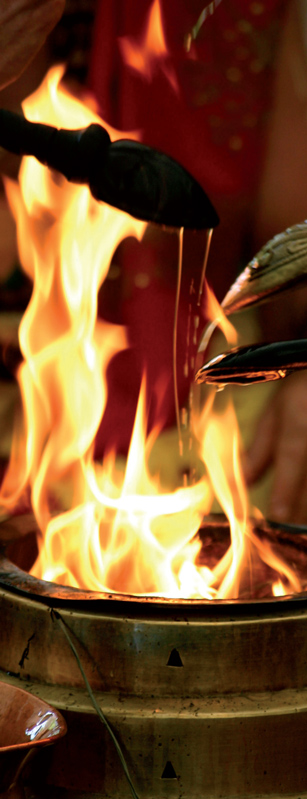The great spiritual teachings of the ancient world — deriving from an era before our consciousness became dominated by the rational mind — speak primarily in terms of symbols. Vedic sages articulated this approach stating that “the Gods love the mysterious and dislike the obvious.” The wise often avoid stating anything directly because most people are unprepared to see the truth. The wise prefer to intimate the truth to real seekers whose minds are receptive, rather than trying to broadcast it to those who are not really interested. Their goal is to stimulate our own insight and experience, not merely to pass on a belief or idea as final.
Spiritual truth transcends mere words. Whatever is put into words immediately becomes profane, a commodity capable of manipulation and distortion. Truth is not the evident form, but the hidden fire. We cannot find truth in outer forms any more than we can see fire in wood that has not been enkindled.
For the ancient sages the soul was the sacred fire. No philosophy was necessary to explain its self-evident effulgence. They lit its flames on their altars and in their hearts as the Divine consciousness coming forth from the material world. Through it, they achieved a state of consciousness far beyond our current idea of intelligence as defined by the scientific mind and its emulation of external reality. Through it they touched the cosmic mind of which our human mind is but a spark.
The sacred fire was their main tool of communication with both inner and outer worlds, through which they could contact channels of universal thought and energy as easily as we can tune into the different broadcasting stations. Meditating on the sacred fire linked them with the sacred order of life, which they called “sacrifice” owing its interdependence. They became a sacrifice, as it were, offering their lives to the cosmic fire. Their human personality was exchanged for a sacred role as guardians of the light.
Native and tribal peoples today remain closely connected to the sacred fire. They perform regular rituals to honor the sacred link with the universe that fire represents, much like the ancients once did all over the world. They sustain the bond of the sacred fire in an age that has forgotten the luminous origins of life.
Such fire rituals are called yajnas (pronounced “yagyas”) in the Vedic tradition. There are daily, monthly and seasonal fire rituals for keeping us in harmony with the cosmic movement of the light. There are special fire rituals for specific purposes, like the achievement of personal goals such as prosperity, or spiritual goals such as the reduction of negative karmas. There are broad social fire rituals for universal peace and the general well-being of the world. Some yajnas are specifically astrological in nature. Many Hindu temples still perform such fire rituals, particularly in South India. Certain modern Hindu movements like the Arya Samaj and Gayatri Pariwar emphasize them as part of daily practices for everyone.
When we participate in such special or sacred fires, particularly at key transitional points of sunrise and sunset, full moon nights or the solstices, we enter into the universal order of light. We become part of the day, the month and the year. The universe begins to stir inside us and work its magic of growth and change. Time becomes a process of transformation, nourishing our inner light and ripening our souls.

The ancient global fire religion
Our human species is a species defined by the discovery of fire. Fire, we could say, was the first teacher of our species through whom we learned our main arts, crafts and sciences. The sacred fire was the basis of the first human culture, which was the culture of fire.
The religion of fire was our first religion from the days the cavemen built their first fires and felt the great mystery of life. The fire was our first guru in the infancy of our species from which we learned the secrets of light and consciousness. The sacred fire, we could say, is the spiritual ancestor of all people of all races and continents. The religion of fire remains our natural religion— the very basis of our aspiration as a species to find the light.
The great ancient fire religions of India, Persia, Ireland, Greece, China, Israel and Mexico are but different facets of a universal and eternal fire teaching. These religions of light arose organically before any particular organized religion or code of belief was defined. They projected the religious urge at the start of our civilizations, setting in motion our spiritual aspiration as a species that remains our inner sustaining force. The Rig Veda, perhaps the oldest book in the world, begins with the image of the fire sacrifice:
I worship the Sacred Fire (Agni) that is chief priest, the deity of the sacrifice, who works according to the seasons, the invoker, best to grant the treasure.
The Sacred Fire honored by the ancient sages is invoked again by the new. For us he manifests all the Gods.
 To you, oh Fire, day by day, by dawn and by dusk we come bearing our offering of surrender, the king of the sacred rite, the guardian of truth, flourishing in his own nature.
To you, oh Fire, day by day, by dawn and by dusk we come bearing our offering of surrender, the king of the sacred rite, the guardian of truth, flourishing in his own nature.
The Rig Veda explains this inner fire or Agni as the principle of light in nature and in our own souls:
Thou, oh Fire, shining forth throughout the days, from the waters, from the stones, from the forests and from the herbs, thou oh Lord of souls are ever born pure!
Oh Fire, whom the waters, the mountains and the forests carry as the child of truth, you are enkindled with force by men on the summit of the Earth. You have filled with your radiance both the worlds and stream with smoke in Heaven.
A related ancient text, the Atharva Veda, states the allpervasiveness of the Divine fire principle in its Hymn to the Earth:
There is a Divine fire in the Earth and in the plants. The Waters carry the fire and the same fire dwells in the rocks. There is a fire within human beings, within the cows and the horses are sacred fires.
The Divine fire shines from heaven as the Sun. The Divine fire extends the wide atmosphere through the wind. Mortals enkindle the Fire that carries their prayers, which loves clarity.
Such statements became the foundation of the Hindu religion, what is called ‘Sanatana Dharma,’ the eternal dharma or eternal tradition of the truth. Out of it came Buddhist, Jain and Sikh traditions that similarly reflect a vision of enlightenment as the supreme goal of life. Yet not only the Hindu but also the Zoroastrian religion – whose vision of the universe as a play of light and darkness had a strong impact on both Judaism and early Christianity – was centered on the sacred fire. The ancient Persians, who had a language and religion close to the Vedic, built fire temples on their mountaintops and echoed similar thoughts in their most ancient scripture, the Zend Avesta:
We worship the Fire, the son of God, the holy lord of the ritual order. And we worship all the Fires and the mountain that holds the light. And we worship every holy celestial spirit and every holy earthly spirit.

The most holy site of the ancient Greeks, the temple of Delphi, had a place for “the Central Fire behind the universe” at the apex of its famous pyramidal symbol designed by Pythagoras himself. The great Greek pre-Socratic philosopher Heraclitus created an entire sacred philosophy of fire. The Romans also had their sacred fires, as did all the ancient Europeans. Fire was the ancient Celtic God of wisdom. A Druidic poet states:
I am the God who fashions fire in the mind. Who save I knows the secrets of the stone door?
The Lithuanians probably best preserved their ancient European pagan religion based on fire, and continue such practices today as their Romuva religion is undergoing a great revival. Their language is the closest to Vedic Sanskrit of any languages today and reflects how closely these ancient cultures were connected.
The Egyptian Book of the Dead identifies Osiris, the God of the soul who symbolizes death and resurrection, with fire:
I am the great One, the son of the great One. I am Fire, the son of Fire. I have made myself whole and sound. I have become young once more. I am Osiris, the Lord of Eternity.
The Bible refers to the many fire offerings given to the Lord at the great temple in Jerusalem that was the center of Jewish religious life. Moses received the Ten Commandments from God who spoke to him in the form of a burning bush—clearly another symbol of the cosmic fire that has always been God’s main vehicle of expression. The Holy Spirit appeared on the heads of the disciples of Jesus in the form of a flame, reflecting a similar imagery.
The I Ching, the oldest book of China, also recognizes the spiritual symbolism of Fire. This became the basis of the understanding of fire both in Taoism and in traditional Chinese medicine:
THE IMAGE OF FIRE: Thus the great man, by perpetuating this brightness, illumines the four corners of the world.
It also speaks of the ting or fire cauldron into which offerings are made to the Lord of Heaven.
Native Americans have their sweat lodges and kivas based on the sacred fire around which they perform regular chants and rituals. The Mayas and Incas had their great ceremonial fires in their many temples and pyramids. The Cherokees, a great and ancient tribe, speak of the earthen mound (hill or mountain) where the Great Spirit gave them their first fire, establishing them as a people.
These are but a few of the many examples that can be found in all cultures. To deal with them would require an entire book in its own right. The universality of our ancient fire religion is easy to see if we but look with open minds. Unfortunately, those of us caught in the mindset of modern western civilization often regard fire worship as primitive, as mere “nature worship.” But for the ancients, their experience of the Divine was real and concrete, which is why they used the dramatic image of fire. They were reading the book of nature, which is the real scripture or Divine Word written in the language of light. We must recognize this experience of consciousness behind the image of the sacred fire to really appreciate both ancient and native traditions.

While we like to associate the origins of civilization with more material inventions of writing and the first cities, it may more appropriately reside in this ancient fire religion, perhaps even in India, the civilization that has best preserved it. As Graham Hancock notes in his Underworld: Flooded Kingdoms of the Ice Age:
But India, with its vibrant spiritual culture, its armies of ragged pilgrims and its remarkable Vedas raises the possibility that the real origins of civilization could be very different – not driven by economics but by the spiritual quest that all true ascetics of India still pursue with the utmost dedication.
Hancock’s idea echoes the insights of Sri Yukteswar, the guru of Paramahansa Yogananda, one of the great teachers who brought Yoga to the West in the twentieth century. According to Yukteswar, Vedic India and humanity as a whole, reached its highest level of civilization before 6700 BCE, by following the science of Yoga.
Early humanity learned that by making offerings to God through the medium of fire, we could purify our hearts and bring noble aspirations into the world. It discovered that the same fire existed within our hearts as our own soul or sacred spirit. The influence of these ancient fires remains and can come forth again. Just as we cannot deny our family, we cannot deny the fire that is our ancestor across all boundaries of religion, race or culture.
The sacred fire is our father and mother, our grandfather and grandmother, our brother, sister and friend. Yet it is also our child, the fruit of our labor and aspiration that we must cherish and nourish. The sacred fire remains our future goal as well as our deepest root. This ancestral fire of the ancient world remains the foundational creative fire of the worlds yet to be born.
Native and ancient traditions along with meditation-based eastern teachings like the Hindu, Tibetan and Taoist show us how spirituality must be linked with the whole of nature in order to be authentic. This is reflected in the science of Yoga that shows us how to harness the forces of body, breath, sound and consciousness for inner transformation. True spirituality works through the nature within us (our soul) according to its connections with the nature around us (the spirit), using not just the external forms of nature but also the inner consciousness behind it.
It is crucial today that we restore this older natural form of spirituality that is not mere nature worship but uses nature as an experiential path to the transcendent. Seeing how native spirituality interfaces with yogic traditions and traditional systems of medicine (like Chinese medicine or Ayurveda) can help us do this. Through the soul’s connection to the sacred fire we can discover a spiritual life that goes beyond mere belief to a real experience of the cosmic—beyond the mere verbal shadow to the living light.
 The descent of the soul
The descent of the soul
Our birth is but a sleep and a forgetting: The Soul that rises with us, our life’s Star, Hath had elsewhere its setting, And cometh from afar: Not in entire forgetfulness, And not in utter nakedness, But trailing clouds of glory do we come From God, who is our home.
Wordsworth’s verses reflect our experience in childhood during which we fall from the innocence of the soul into the complications, if not corruption of the adult world. This descent of the soul also occurs every day as we fall from the peace of our connection to the Divine in the state of deep sleep to the turbulence of our waking lives. We are a light and a flame that has traveled far—that has descended far from luminous heavens of pure consciousness down to this earthly travail of tears, toil and trauma. We are like children cast out of heaven, sparks of the fire that yearn for the warmth and light of their long lost home.
Yet our birth is also a Divine mission to bring a higher light into the world. We retain a cord within us that we can follow back to our original light. This core soul fire remains in our hearts but its many branches, its streams to enlighten the world, have been extinguished by ego-fires of greed, ambition and domination. We must raise the fire of the soul to consume these lesser fires and bring back the Divine light into the world.
It is crucial today that we relight our ancestral sacred fires to reclaim our spiritual heritage as a species and renew our link with the sacred universe. Such a return to origins is the necessary foundation to build a true spiritual civilization, a new humanity in tune with the entire universe. Our future as a species rests upon the return of the sacred fire, as the beacon of a new humanity, at one with nature, yet capable of moving to the stars!
Our heritage is that of fire. But what type of fire will be our legacy—that of aggression, conflict and war, or that of love, beauty and truth? This depends upon the fire that we build our lives around, and whether it is sacred or unsacred. Which fire will you choose? Our destiny will be that of our flame.
 David Frawley (Acharya Vamadeva Shastri) is regarded as an authentic Vedacharya or Vedic teacher in India. Author of numerous books and course materials on Yoga, Ayurveda, Vedic astrology, Vedanta and the Vedas, his works have been translated into several languages and are regarded as authoritative texts in the fields. He conducts training programs worldwide, working towards promoting the main branches of Vedic knowledge. www.vedanet.com
David Frawley (Acharya Vamadeva Shastri) is regarded as an authentic Vedacharya or Vedic teacher in India. Author of numerous books and course materials on Yoga, Ayurveda, Vedic astrology, Vedanta and the Vedas, his works have been translated into several languages and are regarded as authoritative texts in the fields. He conducts training programs worldwide, working towards promoting the main branches of Vedic knowledge. www.vedanet.com







